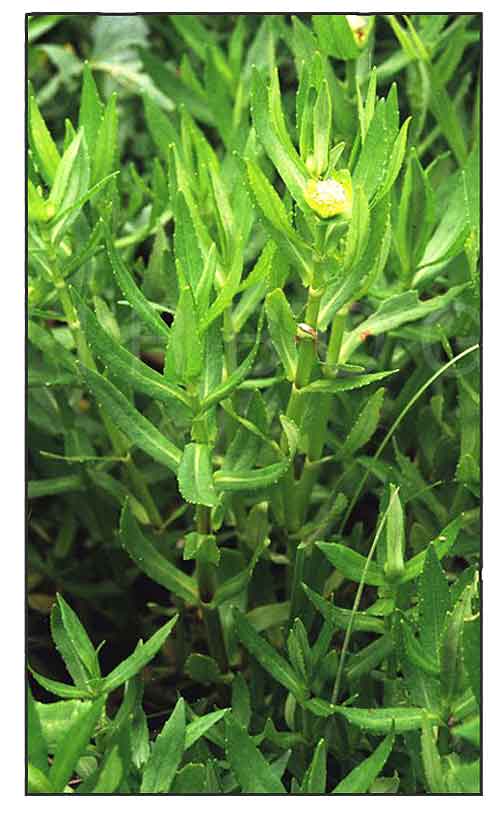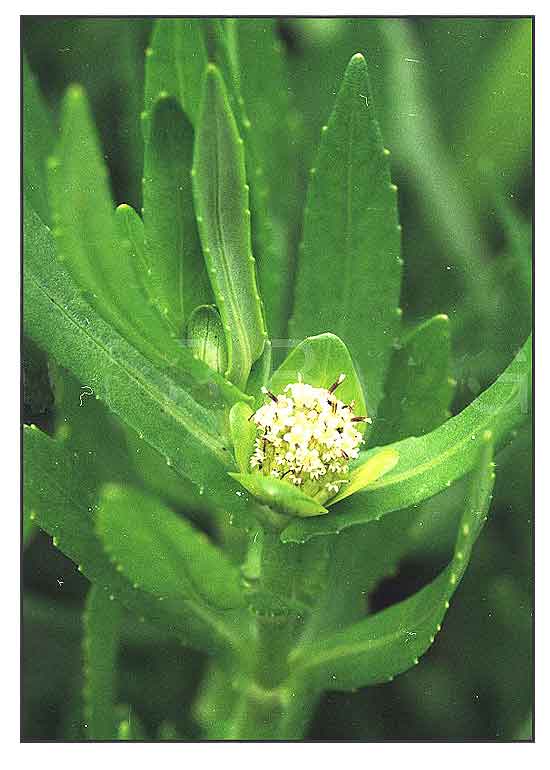 Gen info Gen info
- Enydra is a genus of flowering plants in the Asteraceae or daily family. They are native to the Asian, African, and American Tropics and Sub-tropics.
Botany
Kankong-kalabau is a prostrate, spreading, annual herb. Stems are somewhat fleshy, 30 centimeters or more in length, branched, rooting at the lower nodes, and somewhat hairy. Leaves are stalkless, linear-oblong, 3 to 5 centimeters in length, pointed or blunt at the tip, usually truncate at the base, and somewhat toothed at the margins. Flowering heads are without stalks, borne singly in the axils of the leaves, and excluding the bracts, are less than 1 centimeter in diameter. Outer pair of the involucral bracts is ovate and 1 to 1.2 centimeters long; the inner pair is somewhat smaller. Flowers are white or greenish-white. Fruits are achenes enclosed by rigid receptacle-scales. Pappus is absent.
• Perennial, often gregarious, erect-prostrate or free-floating, aromatic herb, 30-100 cm long. Stem cylindrical, 0.5-1 cm in diameter, hollow, hairy, sparsely branched, rooting at the nodes. Leaves opposite, (sub)sessile, narrowly oblong, 2-10 cm × 0.5-2 cm, base broadly truncate or subcordate, apex narrowly obtuse, margins usually dentate-serrate, finely gland-dotted on both surfaces. Inflorescence a globular head, up to 1 cm in diameter, sessile, solitary, terminal or pseudo-axillary (due to the development of axillary branches), heterogamous, many-flowered; involucre of 4 foliaceous, longitudinally-veined bracts, longer than the flowering heads and completely enclosing them. Ray flowers in many whorls, female; corolla with long tube and 2-5-lobed limb, white or greenish-white; ovary covered by palea which is ciliate at top, style ultimately exserted. Disk flowers more or less numerous, bisexual or sometimes sterile; corolla campanulate with 5-lobed rim; ovary as in ray flower, style arms 2; stamens connate, anthers ultimately exserted. Fruit an achene, oblongoid, 3 mm long, glabrous, closely clasped by the thickened palea (acting as floater), blackish, without a pappus. (36)
Distribution
- Native to the Philippines. (21)
- Other compilations list it as introduced and naturalized.
-
In the Philippines, found only in Rizal Province in Luzon and occasional along the banks of small streams in and about Manila.
- Also native to Assam, Bangladesh, Benin, Burkina, Cambodia, China South-Central, Congo, East Himalaya, Ethiopia, Gabon, Ghana, Gulf of Guinea Is., Hainan, Ivory Coast, Jawa, KwaZulu-Natal, Laos, Malaya, Mozambique, Myanmar, Nigeria, Senegal, Sudan, Thailand, Vietnam, West Himalaya, Zambia, Zaïre, Zimbabwe. (21)
 Constituents Constituents
- Study yielded flavonoids, tannins and saponins.
- Leaf extract study yielded two new chlorine containing melampolids, in addition to three known sesquiterpene lactones.
- Phytochemical analysis yielded alkaloids, saponins flavonoids, triterpenoids/steroid, tannins, carbohydrates, and glycosides.
- Ethyl acetate fraction yielded two flavonoids: baicalein 7-O-glucoside and baicalein 7-O-diglucoside.
- Study showed low ash content and a good source of beta-carotene (3.7 to 4.2 mg/100g on fresh weight basis.
- Study of methanolic extract showed total phenol and total flavonoid contents of 153.08 ± 0.38 mg/mL and 172.04 ± 0.56 mg/mL, respectively. (see study below) (20)
- Solvent extracts of leaf yielded tannin, saponins, and flavonoids. Except for chloroform extract, terpenoid was present in all other extracts. (see study below) (22)
- Study isolated enhydrin (2) and the co-occurring sesquiterpene lactones, viz. fluctuanin (3) and fluctuadin (4). (25)
- Study of leaf essential oil showed a yield of 0.08% w/w, Myrcene, limonene, trans-cis-dihydroperill-
aldehydes were the major components. (26)
- Nutritive analysis of the leafy vegetable yielded moisture 84.25, crude protein 23.42, carbohydrate 8.12, TSS 1.50, lipid 4.16, crude fiber 14.08, ash 14.60.
Methionine was 1.88 g/100 g protein, tryptophan 1.02 g/100g protein, with 163.6 Kcal/100g. (29)
Properties
- Leaves are antibilious.
- Demulcent, cooling, laxative.
- Studies suggested antimicrobial, analgesic, antidiarrheal, antioxidant, anti-cancer, CNS depressant, iron chelating, hepatoprotective, gastroprotective, antibiotic-synergism, thrombolytic, anthelmintic properties.
Parts used
Leaves, young plant parts.
Uses
Edibility
- In Malaya, young parts are used as salad.
- Boiled leaves and stems eaten with rice.
- Sometimes steamed before they are eaten.
Folkloric
- In the Philippines, leaves are pressed and applied to the skin as a cure for herpetic eruptions.
- The Malays use the young parts and bitter leaves as laxative.
- Leaves used for diseases of the skin and nervous system.
- Leaf paste applied to inflamed breasts to reduce inflammation.
- In Calcutta, fresh juice of leaves used as adjunct to tonic medicines; used for neuralgia and other nervous diseases. In Indian medicine, also used for various skin diseases and as a laxative.
- In Assam, India, plant juices used for skin diseases, nervous disorders and high blood pressure.
- Expressed juice of leaves used as demulcent in cases of gonorrhea; mixed with cow's or goat's milk.
- As a cooling agent, leaves are pounded and made into paste and applied cold to the head.
- Plant used for torpidity of the liver. Infusion is prepared the previous evening, boiled with rice and taken with mustard oil and salt.
- In Bangladesh, used by the tribal practitioners of the Marakh sect of the Garos for treatment of diabetes.
(19)
- In Ayurveda, used for liver disorders, skin and nervous disorders; also, as laxative.
- Mixture of juice with honey taken for smallpox. Plant used as ingredient in steam baths. Leaf preparations used for leprous sores, coughs, and fever. Juice taken with cow's or goat's milk for urinary tract infections. In India, leaves used as laxative, demulcent, and as antibilious. (31)
Studies
• Antimicrobial: Study results showed extract variations, but the methanol extract of A. longifolia, I. aquatica and Enhydra fluctuans showed antimicrobial activity against pathogenic bacteria - S. aureus, P. aeruginosa, E coli and M. luteus. (1) A study in Bangladesh evaluated three medicinal plants (Enhydra fluctuans, Clerodendrum viscosum and Andrographis paniculata) for antimicrobial activity against some pathogenic microorganisms. Methanol extract of leaves of E. fluctuans showed antimicrobial activity with inhibition zones between 6-15 mm with efficacy in the order of E. fluctuans > A. paniculata > C. viscosum. All samples were active against brine shrimp naupulii. (23)
• Antioxidant: Study showed the crude extract to contain flavonoids, saponins and tannins. The ethyl acetate fractions showed the highest free radical scavenging activity
• Analgesic: Study evaluating the analgesic activity showed promising results in both acetic acid-induced writhing and the tail-flick methods. (6)
• Antidiarrheal: Study of the methanol and aqueous extracts of the whole plant showed antidiarrheal activity on castor oil-induced diarrhea. The methanolic extract moderately inhibited growth of S. dysenteriae, S. boydii and S. flexneri; the aqueous extract inhibited growth of S. aureus, S. dysenteriae and S. boydii. (7)
• Flavonoids / Anticancer: Study yielded two flavonoids: baicalein 7-O-glucoside and baicalein 7-O-diglucoside. They were screened for anticancer activity against Ehrlich/s ascites carcinoma bearing Swiss albino mice. Treatment caused a significant decrease in tumor cell volume and increase of life span. Treatment with the flavonoids was found to be cytotoxic in the in-vitro model. (8)
• CNS Depressant Activity / Aerial Parts: Neuropharmacological effects of three fractions of aerial parts were studied using mice models. Results showed significant spontaneous motility depressant, sedative, anticonvulsant and anti-stress activity. (10)
• Flavonoids / Analgesic and Anti-Inflammatory Activity: Study of total flavonoids in Swiss albino mice showed analgesic and anti-inflammatory activity. Analgesic activity was studied using acetic acid induced writhing response and hot plate method. Anti-inflammatory activity was estimated by carrageenan and histamine induced acute inflammation and Freund's complete adjuvant induced chronic inflammation in rats. The results may be attributed to high free radical scavenging and antioxidant potential of flavonoids in the ethyl acetate fraction of E. fluctuans. (11)
• Hepatoprotective / CCl4-Induced Damage: Study evaluated the hepatoprotective potential of EF against carbon-tetrachloride-induced oxidative damage in rats. Results showed the flavonoid rich ethyl acetate fraction to have significant hepatoprotective activity, probably due to the ability of the extract to inhibit lipid peroxidation and increase the anti-oxidant enzymatic activity. (12)
• Antimicrobial / Cytotoxicity: Study evaluated three medicinal plants (E. fluctuans, Clerodendrum viscosum and A. peniculata) for antimicrobial and cytotoxic activities against some pathogenic organisms and Artemia salina (brine shrimp nauplii). All three showed activity against brine shrimp nauplii. A methanol leaf extract of E. fluctuans showed significant efficacy against tested bacteria and fungi. (15)
• Iron-Chelating / Antioxidant: Chelation of free iron can prevent the formation of free radicals. An antioxidant prevents the activity of free radicals either by inhibition or scavenging of free radicals. Study showed E. fluctuans to have both iron chelating and antioxidant activity. (18)
• Anti-Diarrheal / In vitro Antimicrobial Activity: Study of extracts of E. fluctuans showed antidiarrheal activity. The methanolic extract showed moderate inhibitory activity on Shigella dysenteriae, S. boydii and S. flexneri; the aqueous extract inhibited Staphylococcus aureus, S. dysenteriae, and S. boydii. (13)
• Phagocytosis Effects / Leaves: Study evaluated the effect of aqueous extract of leaves on neutrophil phagocytic function. Results showed the extract stimulated chemotactic, phagocytic, and intracellular killing potency of human neutrophils at different concentration. probably through stimulation of cell-mediated immune system. (16)
• Natural Flavonoids / Anti-Inflammatory / Gastric Cytoprotective: Flavonoid isolated from the leaves of E. fluctuans showed anti-inflammatory activity by inhibiting COX-2 and 5-LOX. Its anti-ulcerogenic effect can be attributed to its action on mucosa defense factors. (17)
• Anthelmintic / Antioxidant / Thrombolytic: Methanolic extract was evaluated for anthelmintic and thrombolytic activities. Results showed significant antioxidant activity with IC50 of 135.20 ± 0.56 µg/mL, with reducing power increasing with concentration. Anthelmintic activity of crude extract against Pheretima posthuma showed concentration dependent effect and compared with albendazole. Clot lysis activity of crude extract was significant (31%) compared to standard streptokinase's clot lysis activity of 40.13%. (see constituents above) (20)
• Cytotoxic / Antioxidant / Leaves: Study evaluated solvent extracts of leaf for phytochemical, cytotoxic, and antioxidant activity. All extracts yielded tannin, saponins, and flavonoids. Except for chloroform extract, terpenoid was present in all other extracts. On brine shrimp lethality assay, the chloroform extract showed highly significant activity of 93.9%. (22)
• Antibacterial / Antibiotic Synergism: Study evaluated E. fluctuans extracts against numerous drug-resistant clinical isolates of methicillin-resistant Staphylococcus aureus and extended-spectrum beta lactamase (ESBL) and metallobetalactamse-producing Escherichia coli and Klebsiella pneumonia. Toluene extracts showed considerable antibacterial activity against gram-negative bacteria. MIC values ranged from 25 mg/mL to 100 mg/mL. Slight evidence of synergism was observed in combination with selected antibiotics. (24)
• Isoflavone Glycoside / Antimicrobial / Leaves: A methanol extract of leaves yielded a novel bioactive isoflavone, glycoside 4',5,6,7-tetrahydroxy-8-methoxyisoflavone-7-O-ß-D-galactopyranosyl-(1>4)-O-a-l-rhamnopyranoside. The compound exhibited antimicrobial activity against various bacteria and fungi.
(27)
• Cytoprotective / Antioxidant /
Experimental Induced Lead Acetate Intoxication: Study evaluated the protective effect of edible extract of E. fluctuans against Pb toxicity. PB altered the extent of ROS production and significantly (p<0.01) induced apoptosis in hepatocytes. The extract exhibited concentration dependent cytoprotective effect against Pb-induced cytotoxicity in vitro. attenuating Pb-acetate mediated toxic manifestations. The extract provided overall protection by promoting Pb clearance coupled with restoration of redox balance. (28)
• Antilithiatic / Effect on Crystal Growth / Antibacterial / Whole Plant: The plant has ethnomedicinal use for treatment of kidney stones and urinary problems. Study evaluated the effect of aqueous extract of whole plant on the growth on calcium phosphate (brushite) crystals. In vitro studies showed the AE at 50, 100, and 200 µg/mL exhibited inhibitory effect on brushite crystal growth. The extract also showed antibacterial effect against S. aureus and exhibited antioxidant activity. (32)
• Protective Against Cadmium Intoxication: Study evaluated the protective role of edible aqueous extracts of E. fluctuans and I. aquatica against Cd-intoxication. Phytochemical analysis revealed substantial amounts of phenolics, flavonoids, saponins, carbohydrates and ascorbic acid. CdCl2 treated hepatocytes exhibited significantly increased levels (p<0.01) of ROS production, lipid peroxidation, protein carbonylation and NADPH oxidase, along with depletion (p<0.01) of antioxidant enzymes and GSH. In in vivo bioassay, CdCl2 treatment caused high Cd bioaccumulation and oxidative stress in the liver, kidney, heart, brain and testes in mice, along with alterations in hematological and biochemical parameters. Simultaneous administration of extracts could significantly restore tested parameters to near normal status. Results suggest the extracts can provide overall protective effect by counteracting Cd mediated oxidative stress and/or promoting elimination of Cd by chelation. (33)
• Cholinesterase Inhibitory / Antioxidant / Potential for Alzheimer's Disease: Study evaluated the cholinesterase inhibitory and antioxidant potential of E. fluctuans extracts. Chloroform extract exhibited highest inhibition against both acetylcholinesterase and butyrylcholinesterase enzymes with IC50s of 83.90 and 48.14 µg/mL, respectively. The chloroform extract also exhibited highest radical scavenging activity (DPPH IC50 113.27 µg/mL) and reducing power (1.916 absorbance at 50 µg/mL). Results suggest a natural source of cholinesterase inhibitors and antioxidants and a potential as functional foods for Alzheimer's disease management. (34)
• Anti-Urolithiatic / Inhibition of Calcium Oxalate Crystallization / In Silico and In Vitro Studies: Study evaluated the effect of aqueous extract of E. fluctuans on in vitro crystallization of calcium oxalate using in vitro nucleation and aggregation assays. In vitro studies showed the extract (50, 100, and 200 µg/mL) and standard cystone (1000 µg/mL) exhibited an inhibitory role in the nucleation process with % inhibitions of 52.69, 43.47, 21.98, and 31.67 µg/mL respectively. Molecular docking studies revealed that 2 out of 35 metabolites i.e. Baicalein-7-O-diglucoside and 4′,5,6,7-Tetrahydroxy-8-methoxy isoflavone-7-O-beta-D- galactopyranosyl-(1→3)-O-beta-D-xylopyranosyl-(1→4)- O-alpha-L-rhamnopyranoside showed modulatory effects on the four renal stone matrix-associated proteins. Results show E. fluctuans may be effective in preventing crystallization of calcium oxalate. (35)
Availability
Wild-crafted.
|

![]()





